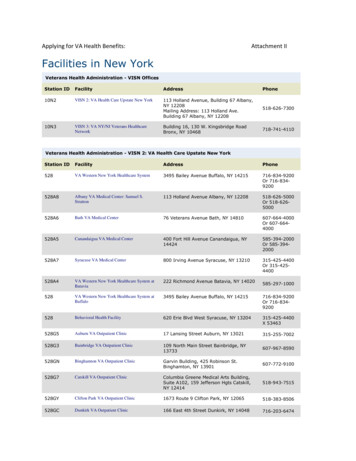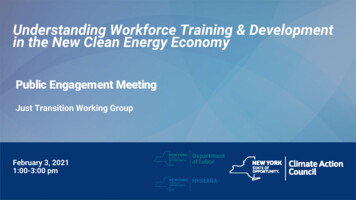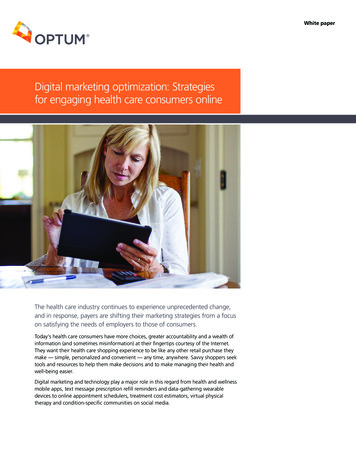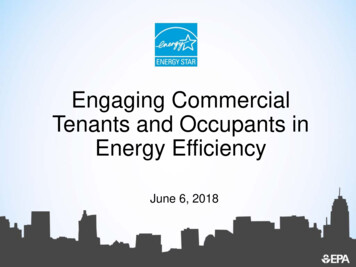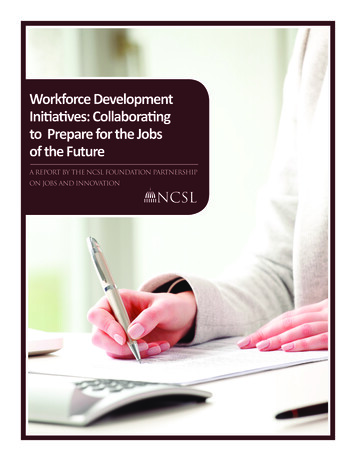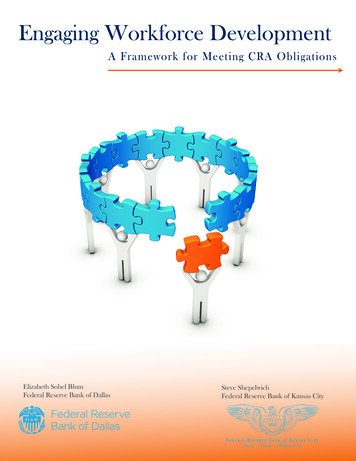
Transcription
Engaging Workforce DevelopmentA Framework for Meeting CRA ObligationsElizabeth Sobel BlumFederal Reserve Bank of DallasSteve ShepelwichFederal Reserve Bank of Kansas CityDenver Omaha Oklahoma City
Engaging Workforce Development: A Framework for Meeting CRA Obligations“Dallas Fed research shows that levels of educational attainment are highly correlated with employment rates and income levels. Unfortunately, educational attainmentlevels in Texas are lagging, particularly for the fastest-growing demographic groups—blacks and Hispanics. It’s not just about who is left behind; it’s about leaving theeconomy behind. Texas high school graduates earn 33 percent more, on average, thanthose who don’t finish high school. College graduates earn 90 percent more than thosewho only have a high school diploma. Workforce development strategies are essential toincrease the employability, productivity and spending power of Texans.” Robert S. Kaplan, president and CEO, Federal Reserve Bank of Dallas“In order to support the long-term prospects of the U.S. economy, it’s critical thatpolicymakers understand the challenges within labor markets. In addition to theFederal Reserve’s policy tools, the regional Reserve Banks can provide informationand other resources, such as this guide.” Esther George, president and CEO, Federal Reserve Bank of Kansas CityAbstract:The workforce development system trains, educates and provides social services toworking-age individuals to enable them to succeed in the labor force and, at the sametime, meet employers’ demand for quality talent. Banks can play an important role inworkforce development. This publication is designed to give banks, and organizationsinterested in partnering with them, tools and information to engage in workforcedevelopment activities in ways that may help them fulfill their obligations underthe Community Reinvestment Act.Federal Reserve Bank of DallasFederal Reserve Bank of Kansas City
Engaging Workforce Development: A Framework for Meeting CRA ObligationsTable of ContentsPart OneAbout Workforce Development1Part TwoHow a Bank’s Engagement in Workforce DevelopmentCan Fit CRA Criteria7Part ThreeCase Studies of Partnerships Between Banks and WorkforceDevelopment Entities15Part FourA Template for Banks to Tell Their WorkforceDevelopment and the CRA Story23Part FiveConclusion28Part SixAppendix 1: Community Reinvestment Act ResourcesAppendix 2: Informational ResourcesAppendix 3: Experts in Workforce Development293135The views expressed in this publication are those of the authors and do not necessarily represent the views ofthe Federal Reserve System. The information presented in this publication is intended for informational useand is not legal advice.Note: In this publication,“bank” refers to financial institutions that are subject to the CRA and “assessmentarea” refers to assessment areas or broader statewide or regional areas that include the assessment areas. Fordetails, refer to the CRA regulation.1Federal Reserve Bank of DallasFederal Reserve Bank of Kansas City
Engaging Workforce Development: A Framework for Meeting CRA ObligationsPart One: About Workforce DevelopmentThe workforce development system trains, educates and provides social services to working-ageindividuals to enable them to succeed in the labor force and, at the same time, meet employers’ demand for quality talent. The primary role of this system is to function as an intermediary ensuringthat employers, trainers, service providers and participants work together to meet their individualand collective goals.Banks can play an important role in workforce development. Some invest in core activities such astraining, education and social services that directly connect workers to jobs. Others provide broaderworkforce development functions, including small-business development, financial education and access to financial products and services that build or maintain assets.By engaging in workforce development, banks can expand on their activities to reach a broader setof stakeholders, develop deeper and more durable, mutually beneficial relationships, and contribute towider organizational and community goals. In addition, banks may find new avenues of involvement intheir markets that leverage their core strengths as financial institutions and as employers.Workforce development is important to the Federal Reserve System. All 12 Federal Reserve Bankshave a community development office with the common mission of promoting community and economic development—including workforce development—and fair and impartial access to credit. TheFederal Reserve Banks of Dallas and Kansas City and other Reserve Banks support workforce development by conducting research, writing publications, designing and hosting events and conveningstakeholders.2 This publication is designed to give banks, and organizations interested in partneringwith them, information and tools to engage in workforce development activities in ways that may helpfulfill their obligations under the Community Reinvestment Act (CRA).The CRA was enacted in 1977 to ensure that banks meet the credit needs of all segments of theircommunity(ies), including low- and moderate-income (LMI) neighborhoods and individuals. Recentguidance on the CRA clarified that “economic development initiatives include provisions for creatingor improving access by low- or moderate-income persons to jobs or to job training or workforce development programs.”3The Workforce Development SystemThe U.S. workforce development system consists of a patchwork of mostly federally funded employment and training providers as well as public, non-profit and for-profit educational and trainingprograms that may provide related social support services. The Workforce Innovation and OpportunityAct (WIOA) is the primary federal legislation that governs workforce development policy (see Box 1).The following sections present an overview of the key actors in workforce development, such asworkforce development boards (WDB), and some of the major strategies employed. The goal is toprovide a general typology of the basic building blocks of the workforce development system. Although there are regional and local variations, workforce development entities can mix and matchbuilding blocks to design initiatives to meet specific labor market needs.Federal Reserve Bank of Dallas1Federal Reserve Bank of Kansas City
Engaging Workforce Development: A Framework for Meeting CRA ObligationsBox 1About the Workforce Innovation and Opportunity ActEnacted in 2014 with bipartisan support, the Workforce Innovation and Opportunity Act(WIOA) was the first legislative reform of the public workforce system in 15 years. Below are keyopportunities presented by WIOA implementation, followed by the potential benefits for banks.1. State-level and regional planning: WIOA requires individual states to develop a strategicand operational plan for the state’s workforce initiatives. Local workforce developmentboards (WDB) outline how they support this plan by creating strategic and operationalplans for their respective regions. Banks can use these plans to help determine which strategies, partnerships, initiatives and programs align with their own priorities. The plans mayalso be useful in establishing the performance context for a Community Reinvestment Act(CRA) strategy. In fact, a bank is encouraged to help tell the story to its regulator aboutits CRA performance, and this is often done through the performance context. Plans arepublicly available on the WDB’s website and are available upon request.2. Disadvantaged-population focus: WIOA emphasizes serving disadvantaged populationsand others with barriers to employment, such as those who have been unemployed overthe long term (typically defined as over 26 weeks), ex-offenders, older workers, out-ofschool youth and low- and moderate-income individuals.3. Partnership and relationship building: WIOA requires workforce boards to strengthenand expand partnerships with organizations that impact workforce development goals.WDBs are required to draw the majority of their board members from the private sector.This emphasis provides banks a framework for connecting with the broader workforceagenda while remaining focused on their core strengths and interests. In addition, it provides banks with greater access to potential partners for other CRA-eligible projects intheir target communities.4. Data and performance metrics: Data collection and reporting are essential tounified planning, program implementation and partnership development. Thisdata can help banks establish their CRA performance context, develop strategies and guide program implementation as well as prepare for examinations anddocument CRA activities.5. Innovation: The overall growth of participants and programs envisioned through the implementation of WIOA and the changes it requires provide a setting for new practices tobe tested and scaled. Banks have an opportunity to identify and shape creative solutionsby working directly with workforce development entities and aligning their other CRAinitiatives with regional and statewide workforce development goals.Federal Reserve Bank of Dallas2Federal Reserve Bank of Kansas City
Engaging Workforce Development: A Framework for Meeting CRA ObligationsThere is no single right approach, structure or program. For example, several of these entities may collaborate on a project or program that targets a specific population, such as veterans or opportunity youth(youth and young adults disconnected from education and employment). In addition, these entities canuse two or more strategies at a time, such as sector strategies and career pathways, to make their effortsmore impactful.Workforce Development EntitiesWorkforce development boards are integral to the workforce system. Every state has a WDB thatdevelops and oversees the state’s overall workforce plan.4 This plan sets the vision, goals, metrics andstrategies for the state. These boards also review statewide policies, certify local workforce developmentboards and coordinate initiatives with other workforce development partners.Every state is divided into local regions, sometimes defined by counties, population or unique characteristics, that are overseen by a local board. The local boards play an important role in the analysis ofregional labor market conditions, development of policies for the use of WIOA-related programmingand funding, and oversight of program implementation within their areas. The state and regional workforce plans are publicly available on each WDB website and upon request.5Each local board manages at least one comprehensive workforce center, or one-stop center, thatprovides a physical location for WIOA-mandated services. These centers are a primary program-delivery channel for workforce services to job seekers, workers and employers.WDBs play an important role in networking with, and organizing collaborations between, themany stakeholders involved in workforce development initiatives, programs and projects. These stakeholders span the public, nonprofit and private sectors (see Box 2). For example, many nonprofit organizations may provide workforce development programs and services, and a WDB can assist in coordinating and leveraging activities across a region. In addition, a WDB may contract with an organizationto provide required services such as career-readiness and skills assessments, individual counseling andcareer planning to eligible clients.Box 2Entities in the Workforce Development SystemParticipants in the workforce development system range from state workforce developmentboards to educational institutions to business groups. The definitions that follow are from aworkforce development vantage point, highlighting each entity’s primary function within thesystem, and are not comprehensive. State workforce development board: Provide guidance, oversight and support for stateworkforce policies Local workforce development board: Lead, coordinate, implement and evaluateworkforce initiatives to meet regional labor market needs Community or technical college: Provide training and education to prepare studentsfor employmentFederal Reserve Bank of Dallas3Federal Reserve Bank of Kansas City
Engaging Workforce Development: A Framework for Meeting CRA Obligations University: Provide education and research to support regional economic development K–12 school: Provide foundational skills and knowledge, exposure to careeropportunities and infrastructure for workforce programs targeting in-school andout-of-school youth Chamber of commerce: Identify and represent the workforce needs of businesses Business, business association or industry group: To help ensure that the local talentpipeline meets business needs, provide data on hiring needs to educators regarding the skills,knowledge and credentials required for jobs, and training and employment opportunities Social service agency: Provide a wide range of support to individuals (e.g., transportation, child care, health care, English as a Second Language (ESL) and adult basiceducation (ABE)) as they obtain or maintain employment Community-based organization: Provide training, job placement services and supportservices that connect to workforce development initiatives (e.g., food banks can providefood scholarships) Labor group: Represent and support the development of trained, skilled workers Officials/administration of city, county, state and federal agency: Coordinate publicresources to fulfill agency commitments toward workforce development goals Philanthropic entity: Provide financial and other support to pilot and scale workforceinitiatives Other community partner: Connect mission and program activities to workforcedevelopment initiativesNote: This information is also in “Regional Talent Pipelines: Collaborating with Industry to Build Opportunities in Texas,” by Elizabeth Sobel Blum and Garrett C. Groves, Federal Reserve Bank of Dallas and Center forPublic Policy Priorities’ report, December 2016.Workforce Development StrategiesWorkforce development consists of a range of strategies to develop talent and skills, connectemployers and workers, and facilitate career mobility. This section outlines many of the most widelyused strategies. Some of them are well-researched and have evidence of positive long-term outcomes(e.g., sector strategies), while others are new and innovative (e.g., two-generation strategies). Somestrategies have a relatively narrow focus (e.g., basic skills improvement or work-based training), whileothers have a broader and more comprehensive focus (e.g., career pathways that include basic skillsimprovement and work-based training). Oftentimes, robust programs integrate multiple strategiesto meet their specific goals. Sector strategies: This tested regional approach to workforce and economic development focuses resources on the needs of a defined industry that is a significant driver in the local economy. Sector strategies are based on partnerships among multiple stakeholders, such as businesses,labor, educational institutions and service providers. They address immediate skill shortagesand develop a talent pipeline for future needs. As a result, sector strategies “promote industry growth and competitiveness and improve worker training, retention and advancement byFederal Reserve Bank of Dallas4Federal Reserve Bank of Kansas City
Engaging Workforce Development: A Framework for Meeting CRA Obligationsdeveloping cross-firm skill standards, career pathways, job redefinitions and shared training andsupport capacities that facilitate the advancement of workers at all skill levels.”6 Career pathways: This strategy organizes education, training, career counseling and supportservices to assist workers in gaining the skills they need to advance in defined industries. Definitions vary, but the main elements of career pathways are stackable credentials, easy entrance andexit points, and support services that increase students’ likelihood of success.7 Career pathwaysrequires collaboration between employers and education and training providers. Employersdefine skill needs, and education and training providers develop programs that teach studentsthese skills. Career pathways can be embedded in broader sector strategies.8 Job-quality strategies: Initiatives are emerging to improve the employment outcomes of lower-wage workers.9 While they take slightly different approaches under titles such as “Raise theFloor” and “high-road employers,”10 they recognize that skill development is important butnot sufficient to secure economic security. Other ingredients include job design, supervisortraining, appropriate benefits and incentives, work scheduling and access to supportive servicessuch as transportation and child care. Taken as a whole, these ingredients provide a more stablework environment for employees as well as direct economic benefits to the employer. “Raise theFloor” strategies are often implemented within the context of sector partnerships as well as withindividual businesses. Basic-skills improvement: Basic skills, sometimes referred to as employability or soft skills,refer to the social and life skills needed to perform as an employee. Employers routinely identify poor employability skills as a major barrier for both new hires and incumbent workersadvancing in their jobs. These skills are often addressed through training components in technical programs or as stand-alone services. Several frameworks address basic-skills improvement.These include the U.S. Department of Labor’s Industry Competency Model11 and the U.S.Department of Education’s Employability Skills Framework.12 Supportive services: These services help an individual participate in job training and employment. Examples include transportation, child care, dependent care and housing, depending onthe individual’s needs. Under WIOA, workforce development boards can provide supportiveservices and need-based payments to assist participants while they are receiving employmentand training services. Such aid provides a significant connection between workforce development and the broader human services sector. Work-based training: Training approaches for employed workers are receiving increased attention, including apprenticeships, work-based learning, on-the-job training and internships. Theseoptions give workers the opportunity to gain skills and competencies related to their current employment and relevant advancement opportunities while receiving income and benefits. WIOAemphasizes these approaches, especially for adults and youth with barriers to employment. Two-generation strategies: These strategies address the needs of both parent and child, withthe goal of breaking the cycle of intergenerational poverty. Traditionally, education, workforcedevelopment and social services have been provided to a specific target group such as low-income children, unemployed adults or disconnected youth. A two-generation strategy workswith families to reinforce and leverage individual success in education and employment and toincrease overall economic security and mobility. The combination of services leads to improvedoutcomes for the family as a whole.13Federal Reserve Bank of Dallas5Federal Reserve Bank of Kansas City
Engaging Workforce Development: A Framework for Meeting CRA Obligations Self-employment: This is a viable option for many trying to enter the workforce. For some,self-employment will result from a drive to create a new business or bring to market a uniqueproduct or service. For others, it can overcome specific barriers to traditional employment, suchas past felony convictions or age. WIOA supports entrepreneurial training toward the goal ofself-employment and related services for youth, adults and disadvantaged populations. Whilethis strategy is not widely used, there is potential to expand
those who don’t finish high school. College graduates earn 90 percent more than those who only have a high school diploma. Workforce development strategies are essential to increase the employability, productivity and spending power of Texans.” Robert S. Kaplan, president
